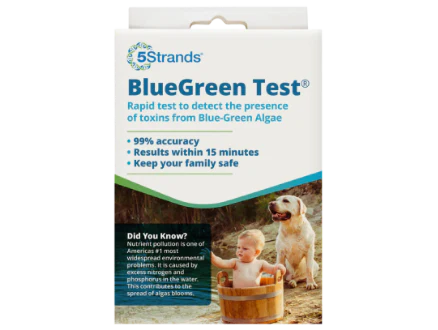A fun day at the beach or lake can sometimes turn deadly. We are seeing more and more reports over the last year of families losing their pets due to toxic algae. Most recently published in the St. Louis on Harvest Public Media was a story of a family that lost their golden retriever due to toxic algae exposure after a fun day in the lake.
It was supposed to be a fun weekend getaway to celebrate Mandi Miller’s 30th birthday, stated Elkins. Their 115 lb golden retriever wadded in the lake and drank the water. Later that night, he started vomiting. Next came the seizures. The family rushed to the nearest vets office but ended up pulling over to the side of the road to say goodbye until he was gone.
Little did they know, their family pet had suffered from toxic algae poisoning.
Not only did they have to suffer from their loss, they began to develop symptoms a few days afterwards. They had sores all over their body, muscle aches, vomiting, and gastrointestinal issues. A blood panel revealed severe liver damage.
Stories like this are popping up all over the country. With the climate changes, these exposures seem to be happening all year round and not just in the summertime when conditions are just right for a potential bloom.
Most people have no idea about the dangers or severity of these toxins. So let's take a closer look and find out more about this colorful threat.
What is Blue Green Algae?

Toxic algae blooms can occur throughout the U.S. and Canada, according to the U.S. Environmental Protection Agency. They are not always blue-green but can be red and brown, and can occur in freshwater or saltwater. The “algae” or “pond scum” is actually cyanobacteria. These bacteria can produce toxins (such as microcystins and anatoxins) that affect dogs as well as people, livestock and other pets that swim in and drink from algae-contaminated water. Cyanotoxins are powerful natural poisons, including ones that can cause rapid death by respiratory failure.
Though cyanobacteria isn’t visible to the naked eye, it looks like algae when it clumps together in bodies of water. Toxic algae can also bloom in backyard pools and decorative ponds if they aren’t cleaned regularly.
Toxic blooms can result from more than 30 species of cyanobacteria, which produce four types of toxicity:
- Hepatotoxin (damages the liver)
- Neurotoxin (destroys nerve tissues)
- Nephrotoxin (destroys cells of the kidneys)
- Dermal toxin (causes hives or a rash)
Signs/Symptoms Your Patient May Have Ingested Blue-Green Algae
The rapid onset of signs of cyanobacteria illness does not leave much time for treating the animal. Symptoms can begin anywhere from 15 minutes to several days after exposure. Clinical signs of poisoning are dependent on the toxin involved.
Microcystin is a hepatotoxin - Microcystins can result in liver damage or failure. Since many body functions depend on a liver that is functioning properly, a wide list of symptoms or issues will arise as the liver begins to fail.
Signs of liver injury from hepatotoxins include:
- Weakness
- Disorientation
- Lethargy
- Lack of appetite
- Vomiting
- Diarrhea (dark, tarry stool)
- Bleeding, blood in stool
- Pale gums
- Jaundice (yellow tint to gums and skin)
- Shock
- Seizures
- Collapse and coma
- Death
Anatoxins are a neurotoxin that result in neurotoxicity. Anatoxins can cause signs of poisoning within 30 minutes of exposure. With this type of exposure, death can be quick-typically within minutes to hours after exposure.
Signs of neurotoxicity include:
- Weakness or inability to walk
- Excessive salivation
- Excessive tearing
- Difficulty breathing
- Blue discoloration of skin and mucous membranes
- Tremors
- Seizures
- Muscle rigidity
- Paralysis
- Disorientation
- Coma
- Death
Diagnosis and Treatment
Unfortunately, there is no antidote for the toxins produced by blue-green algae, and the prognosis for an affected dog is poor. Aggressive and immediate veterinary treatment is necessary to help treat the patient. Sadly, in some cases, euthanasia is the only option. According to the VCA Hospitals website, other treatments can include:
- Induce vomiting to remove the algae
- Oral activated charcoal to absorb toxins
- Pump their stomach
- IV fluids and plasma
- Muscle relaxers
- Anti seizure medications
- Oxygen therapy
- Vitamins
- Antibiotics
- Nutritional supplements

However, most of the time treatment is limited to supportive care for the affected organs.
Recovery is possible if it is caught in time. For those pets that do recover from cyanobacteria, they will have lingering liver damage and other possible complications.
While not all blue-green algae are toxic, you can not tell just by sight which are toxic. Assume all blooms to be dangerous until they are tested.
Blue-Green algae typically will give off a blue-green shimmer on the water surface. It may look like someone just threw paint on the water. There could be a slimy, scummy or foamy mat or film on the water. However, please note that not all blooms may be visible. Some blooms can be lurking below the water surface. Be weary of any water where you can not see your feet. It might be contaminated.
So how do we keep our pets safe from Blue-Green algae?
The best and most effective way of protecting your dog from the dangers of blue-green algae is to prevent them from coming into contact with it.
Some of the ways you can keep your dog safe from exposure include:
- Cleaning your dog properly if they go for a swim in water
- Preventing your dog from drinking out of bodies of water
- Fence off contaminated ponds and lakes
- Remove standing water from plant containers, birdbaths, fishponds, and fountains
- Rinse your dog with clean water after then take a swim
OR YOU CAN NOW TEST THE WATERS BEFORE ENTERING
This is where 5Strands Affordable Testing comes in. The BLUEGREEN TEST® is the world's first rapid diagnostic test to detect a broad range of hepatotoxins on-site. It utilizes a single step, sandwich type, non-competitive immunocomplex assay method, using combinations of antibodies detecting molecular structures present in all common microcystins and nodularins. This combination enables the test to detect eleven commonly occurring hepatotoxins in a single test and can detect levels below 0.1 µg/L. and takes just 15 minutes to process with immediate, sensitive and indicative results.

Help spread the word about the dangers of this deadly toxin. Let others know that there is now an on-site test available for only $35.00.
You and your pet are worth every cent!


























